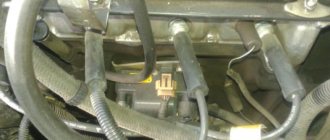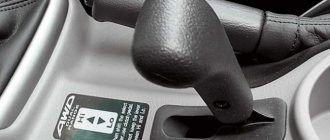The cost of owning a car is made up of many factors, one of the main ones being fuel consumption. Let's figure out what gas consumption for the Lada Niva (Chevrolet) is indicated in the technical specifications. And how different it is from real owner reviews.
Modifications
Chevrolet Niva (212300 - 55) first rolled off the assembly line back in 2002 and immediately gained popularity among drivers thanks to its good cross-country ability, powerful engine, reliability and low maintenance costs.
In its entire history, the car has experienced only one restyling in 2009 a modern appearance.
Niva Chevrolet 1.7 l
The heart of the Chevy Niva is the VAZ-2123 four-cylinder gasoline engine , developed on the basis of the VAZ-21214 injector back in the 90s of the last century.
Technical characteristics VAZ-2123 engine :
- volume – 1.7 liters
- power – 80 hp
- torque - 127.5 Nm (at 4000 rpm)
- maximum speed – 140 km/h
- acceleration time to 100 km – 19 seconds
The engine was updated and improved several times, was modified and transferred by designers from the Euro-2 environmental standard to modern Euro-5 standards.
Since the end of 2015, all cars have been produced only with a Euro-5 class engine.
Niva Chevrolet 1.8 l
FAM-1 (VAZ-21236) was produced from 2006 to 2008. 1.8- liter Opel Z18XE .
Its technical data was superior to the VAZ engine:
- volume – 1.8 liters
- power – 122 hp
- torque – 167 Nm (at 3800 rpm)
- maximum speed – 165 km/h
- acceleration time to 100 km – 12 sec
The cost of the Chevy Niva in this configuration was much higher, so it was not in great demand, and in less than two years it was withdrawn from the market. However, such fields still travel safely on the roads of the country.
Fuel consumption
One of the most discussed topics among car owners is: what is the fuel consumption of the Chevrolet Niva? Let's figure it out. Consumption depends on many parameters, both on the characteristics of the car itself and on its operating conditions. Each specific car will always have its own, but there are fuel consumption standards set by the manufacturer. They are presented below, per 100 km.
Consumption of Chevrolet Niva 1.7 l Euro-2
- urban mode - 10.8 l
- highway consumption (5th gear, speed 90 km/h – 8.6 l
- highway consumption (5th gear, speed 120 km/h) – 11.6 l
Consumption of Chevrolet Niva 1.7 l Euro-5
- urban mode - 14.1 l
- highway consumption – 8.8 l
- average consumption – 10.2 l
Interestingly, the updated engine with the Euro-5 environmental standard has increased fuel consumption, but its power has remained unchanged.
Consumption of Chevrolet Niva 1.8 l
- urban mode - 12.7 l
- highway consumption – 10.4 l
- average consumption – 8 l
Chevrolet Niva - consumption according to the passport and real
Chevrolet Niva cars went on sale in 2002. The model has gained popularity largely due to its increased cross-country ability and unpretentiousness in terms of service. It is produced in a station wagon body, the configuration includes a number of additional equipment.
As practice shows, the fuel consumption of the Chevrolet Niva has become another reason why consumers from the CIS countries chose this model.
The relevance of this theory is confirmed by reviews from owners.
Of course, if it is necessary to reduce consumption costs, the Chevrolet Niva fuel consumption rate can be reduced, but this must be done provided there are objective reasons for this.
Together, AvtoVAZ and General Motors created the compact SUV Chevrolet Niva in 2002. The model today is considered one of the most sought-after and popular among domestic car enthusiasts. The car is widely used due to the fact that permanent all-wheel drive is already provided in the basic configuration.
In 2009, the manufacturer carried out the first restyling, which entailed some cosmetic changes. Those who are just thinking about buying a Russian SUV are interested in a completely logical question: “what is the fuel consumption of the Chevrolet Niva and does the figure correspond to the stated standard?”
Also interesting: Tuning a Niva 4x4 with your own hands: updating the interior of the Lada VAZ-2121
If you fully load the trunk or add a trailer, the consumption will increase to 2 liters per 100 km (taking into account that there is a driver and 1 passenger in the cabin).
Low dynamics appear if you reduce gasoline consumption. In this case, acceleration to “hundredth” will take 19 seconds. The maximum speed will be 140 km/h.
Fuel consumption will be more economical if you change driving modes. On the highway it’s about 10 liters, while quiet city driving will require 12-13. If you choose mixed modes, you can achieve figures of 11 l/100 km. Feature: in this case, oil consumption increases.
How to reduce fuel consumption
If you think that your car has high gas mileage, you can try to reduce it using the following methods:
- adhere to a calm, non-aggressive driving style;
- change fuel and air filters on time;
- monitor the tire pressure (optimally 2.1 - 2.2 atmospheres);
- use high-quality motor oil and good gasoline;
- monitor the technical condition of the car, especially its brake system;
- do not carry extra cargo in the car that makes the car heavier;
- Warm up the engine in cold weather.
Owner reviews
In most cases, the fuel consumption of the Chevrolet Niva is close to the standards stated by the manufacturer, as evidenced by reviews of real car owners .
Reviews for Niva 1.7 l
- Alexander, Tolyatti . I finally replaced my old Niva with a new 2020 Chevy. I'm happy with the car, the first maintenance is over, the mileage is already 12,000 km and we can talk about consumption without discounts for running-in. The new Chevrolet Niva's fuel consumption in the city, without the air conditioner on, is about 8.6 liters per 100 km, while the old one, also with a 1.7 liter engine, was about 12. Which is very pleasing.
- Igor, Moscow. I've been driving Nivas for 10 years of my life, now I drive a 2013 Chevrolet Niva with a 1.7 engine. The car is great for weekends and off-road driving. You quickly get used to it and forgive many shortcomings, even constant breakdowns. But if you have hands, then it’s not scary. I use it more than actively, I use about 14 liters of AI-92 gasoline per 100 km in the city and a dozen on the highway at an average speed of 100 km per hour.
- Anton, Barnaul. After moving to the private sector, I had to change from the usual Priora. Now I drive a 2008 Chevrolet Niva with a 1.7-liter engine, I bought it second-hand based on an ad on the website. In the villages this is a car for life, here I appreciated all its advantages, despite the far from the best technical condition of the car (after all, the unit is 10 years old). Gasoline consumption per 100 km in the city is about 15 liters, and on the highway 10 liters - I think this is normal.
- Bogdan, Novosibirsk. I bought the car second-hand, a year old. I needed an SUV, and the amount for purchase was limited. The choice fell on the Chevy, and so far I have never regretted it. I liked the cross-country ability and inexpensive maintenance, low cost of spare parts, but the dynamic characteristics of the Niva, for that kind of money, leave much to be desired, and the interior is a bit cramped for me. But it consumes little gasoline - on average 10 liters on the highway and 12 in the city with an engine displacement of 1.7.
- Renat, Abakan. Being a lover of outdoor recreation, after selling an old 14, I chose a Chevrolet Niva with a 1.7 engine. The engine is of course rather weak, but fuel consumption per 100 km is from 8.5 to 12-13 liters, which is very economical. Another plus is good body geometry, cross-country ability, suspension, price, but I would like a larger trunk, after all, the car is for long-distance and country family trips.
Reviews for Niva 1.8 l
- Oleg, Ufa. After I moved out of town, I realized that I urgently needed to change my car. My Ford Focus II did not drive at all in winter, and in the autumn mud, getting home often became problematic. I decided on a Chevy with a 1.8-liter engine producing 122 hp. I have fully appreciated all the pros and cons of the car over 120 thousand kilometers; I will not list them all. Gasoline 92 consumes about 13-15 liters in the city consistently. I have now sold the car and will update it.
- Alexander, Magnitogorsk. Chevy, of course, is not a dream car, but it is a worthy option. I'm pleased with the chassis and good cross-country ability, the interior is spacious and comfortable, although the stove does heat up, but the air conditioning can't cope. On a 2010 Chevrolet Niva with a 1.8 liter engine. My fuel consumption on the highway is 10 liters, and in the city 13-16!!! Too much for so many horses.
- Artem, Yuzhno-Sakhalinsk. The car served me for 2 years, I drove 60,000 km across the country, from Sakhalin to Belarus. The iron horse served faithfully, but parted ways due to the purchase of a new SUV. He doesn’t eat much, with a 1.8 liter engine, fuel consumption at idle is 1.9-2.2 liters per hour, on the highway it was an average of 11 liters, in the city more than 14.
- Peter, Perm. A good car just for our Russian roads, but for men who can at least fix something on their own, otherwise you will go broke. I am glad that the fuel consumption is low and corresponds to what was declared by the factory: the Chevrolet Niva fuel consumption rate on the highway is 10.4 liters, for me at a speed of 90-100 km/h it reached 8 liters, at 120-130 km/h - 10.5 liters , in the city it opens 12-13.
Video of the trip 2500 km. and review of consumption:
Actual fuel consumption per 100 km
Many copies were broken in the discussion of the Niva on car enthusiasts forums. They talked about everything - maneuverability through forests and cities, appearance, frequency of breakdowns. Including fuel consumption.
- Dmitry, Irkutsk . A year ago I replaced my beloved Niva with a 2020 Chevy. I have already done the maintenance and traveled 12,000 kilometers. Measurement time. The old swallow in the city without air conditioning spent 12 per hundred square meters (the engine was also 1.7), the new one - 8.6. Pleases.
- Konstantin, St. Petersburg . I've been using Niva for ten years now. Now the car is 2013 with a 1.7 engine. The cross-country ability is good, it flies easily off-road, and is easy to control. I ride often. I found only one downside - it often breaks due to small things. True, my hands are growing from the right place, so I can cope. Gasoline consumes about 14 liters per hundred square meters in the city and 10 on the highway (if you drive at 100 km/h).
- Andrey, Tula . My wife and I moved from an apartment to a private house, we had to exchange our own Priora for a 2008 Niva, which was no longer new, of course. Suitable for living in the village! It will go off-road in any weather, you can even load it with bricks, repairs cost a penny. Fuel consumption is normal - 15 liters in the city, on the highway - 10.
- Gregory, Dorogobuzh . We often travel in groups out of town with tents. Six months ago I sold my old 14 and bought a Chevrolet Niva 1.7. After five months of active driving, I can say that the engine is not very powerful, but the fuel consumption is good (I spend from 8.5 to 13 per hundred kilometers). I also liked the strong suspension and body geometry. If only there was a bigger trunk...
Slightly different reviews about Niva 1.8:
- Egor, Perm . My parents live in the village and have been getting sick a lot lately. Getting there in an old Ford is quite an adventure. There was more mud than lava in the vicinity of Orodruin, before leaving we could only pray that we wouldn’t get stuck. A couple of months ago I gave up and started a Chevrolet Niva 1.8. It spends a decent amount of fuel - 13-15 liters per hundred square meters, but it runs like a beast off-road. Nothing to regret.
- Ivan, Moscow . Shevik is not a dream car, of course, but you can live with it. Chassis, spacious interior, warm inside in winter. In the summer, however, I feel like a sardine in a can - the Conder barely pulls. And money for gasoline flies away - on the highway it takes 10 liters, in the city - up to 16. That’s a lot for such power, I think.
- Roman, Nizhny Novgorod . I often travel around the country on vacation, visiting eight or nine cities a year. I drove around on my trusty Niva 1.8 for two years, and now I’ve sold it (bought a new SUV). I was glad that it never broke down on the road. If any problems arose, he fixed them himself, moving aside. Gasoline consumption was also normal - an average of 11 on the highway and 14 in the city.
- Igor, Torzhok . I’ve been using the Niva for four years, although I try not to drive around the city too much - it consumes 13-14 liters per hundred square meters, which turns out to be a bit expensive. Well, only if you're shopping for groceries at the wholesalers - the spacious body and trunk allow you to cram in a couple of kilos of chicken, pork and potatoes. But as soon as I’m going out of town, I immediately roll the swallow out of the garage. It drives briskly along country roads and can even drive into the forest without any problems. On the highway at a speed of 130 km/h it takes 10.5 liters. I consider it a normal indicator.
In general, the reviews are very different. For some motorists, the consumption seems prohibitively high, for others it seems just normal.
By the way, recently the optimal consumption is 6 liters per 100 kilometers.
Niva has more. On the other hand, this is an SUV, not a subcompact Daewoo Matiz.










